Maximising Resources for Business Success: An Analysis
VerifiedAdded on 2022/03/03
|13
|2302
|23
Report
AI Summary
This report examines strategies for maximizing resources to achieve business success. It begins by exploring the impact of technology, particularly focusing on Intel's various technological advancements such as AI, IoT, 5G, Cloud Technology, and Edge computing. It then delves into the resources needed by organizations across different business sectors, the importance of monitoring these resources, and the use of benchmarking and performance indicators. The report also highlights the essential skills required for efficient project management, including communication, leadership, time management, risk management, and critical thinking. It outlines the project life cycle phases, the significance of identifying critical factors, and the tools used for project management, such as network diagrams, CPM, and WBS. Furthermore, it discusses the importance of project evaluation and review. Finally, the report defines 'excellence' and 'quality' and their impact on organizations, including tools like flowcharts, histograms, and control charts, used to ensure product and service quality. This comprehensive analysis provides valuable insights into achieving business success through effective resource management and quality assurance.
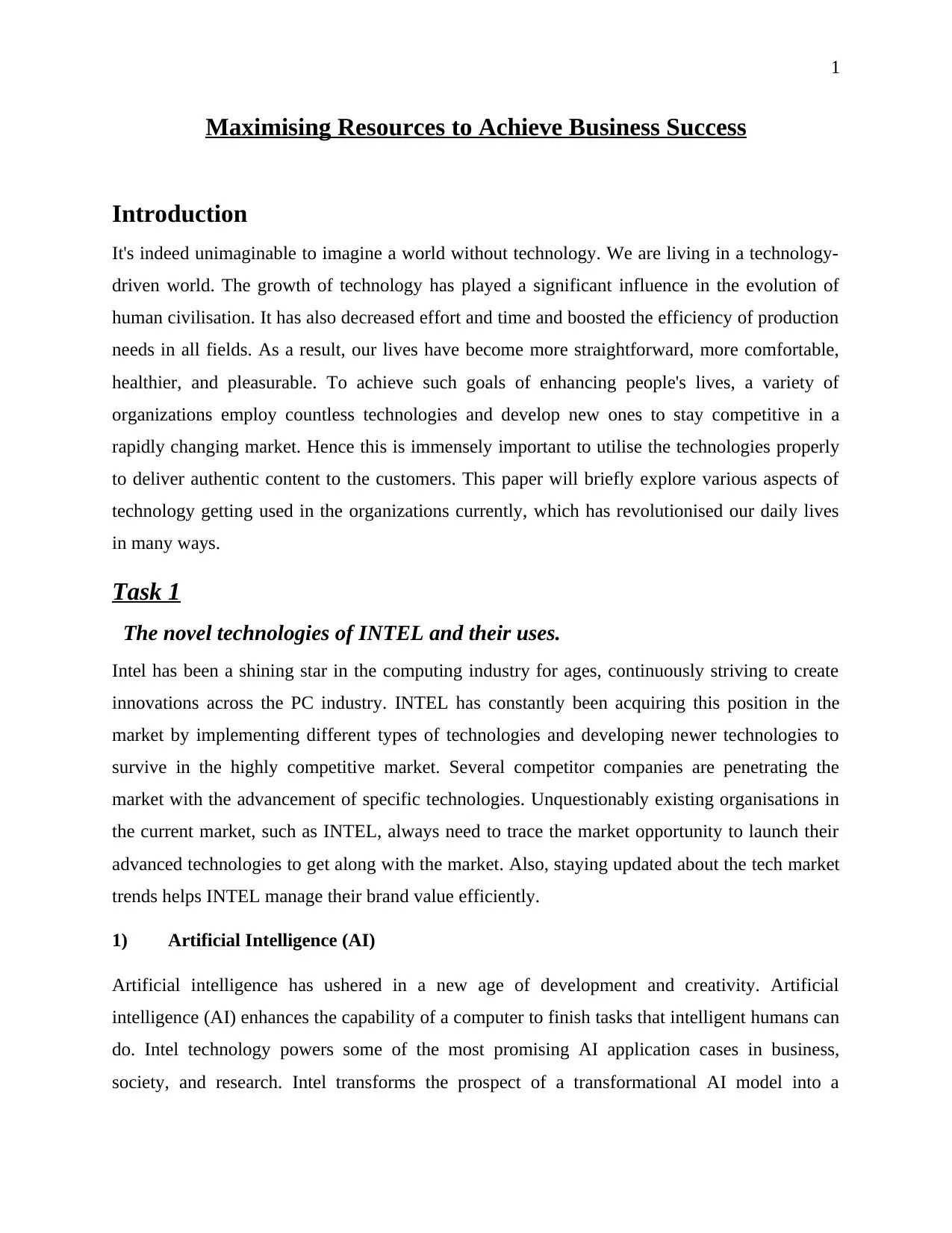
1
Maximising Resources to Achieve Business Success
Introduction
It's indeed unimaginable to imagine a world without technology. We are living in a technology-
driven world. The growth of technology has played a significant influence in the evolution of
human civilisation. It has also decreased effort and time and boosted the efficiency of production
needs in all fields. As a result, our lives have become more straightforward, more comfortable,
healthier, and pleasurable. To achieve such goals of enhancing people's lives, a variety of
organizations employ countless technologies and develop new ones to stay competitive in a
rapidly changing market. Hence this is immensely important to utilise the technologies properly
to deliver authentic content to the customers. This paper will briefly explore various aspects of
technology getting used in the organizations currently, which has revolutionised our daily lives
in many ways.
Task 1
The novel technologies of INTEL and their uses.
Intel has been a shining star in the computing industry for ages, continuously striving to create
innovations across the PC industry. INTEL has constantly been acquiring this position in the
market by implementing different types of technologies and developing newer technologies to
survive in the highly competitive market. Several competitor companies are penetrating the
market with the advancement of specific technologies. Unquestionably existing organisations in
the current market, such as INTEL, always need to trace the market opportunity to launch their
advanced technologies to get along with the market. Also, staying updated about the tech market
trends helps INTEL manage their brand value efficiently.
1) Artificial Intelligence (AI)
Artificial intelligence has ushered in a new age of development and creativity. Artificial
intelligence (AI) enhances the capability of a computer to finish tasks that intelligent humans can
do. Intel technology powers some of the most promising AI application cases in business,
society, and research. Intel transforms the prospect of a transformational AI model into a
Maximising Resources to Achieve Business Success
Introduction
It's indeed unimaginable to imagine a world without technology. We are living in a technology-
driven world. The growth of technology has played a significant influence in the evolution of
human civilisation. It has also decreased effort and time and boosted the efficiency of production
needs in all fields. As a result, our lives have become more straightforward, more comfortable,
healthier, and pleasurable. To achieve such goals of enhancing people's lives, a variety of
organizations employ countless technologies and develop new ones to stay competitive in a
rapidly changing market. Hence this is immensely important to utilise the technologies properly
to deliver authentic content to the customers. This paper will briefly explore various aspects of
technology getting used in the organizations currently, which has revolutionised our daily lives
in many ways.
Task 1
The novel technologies of INTEL and their uses.
Intel has been a shining star in the computing industry for ages, continuously striving to create
innovations across the PC industry. INTEL has constantly been acquiring this position in the
market by implementing different types of technologies and developing newer technologies to
survive in the highly competitive market. Several competitor companies are penetrating the
market with the advancement of specific technologies. Unquestionably existing organisations in
the current market, such as INTEL, always need to trace the market opportunity to launch their
advanced technologies to get along with the market. Also, staying updated about the tech market
trends helps INTEL manage their brand value efficiently.
1) Artificial Intelligence (AI)
Artificial intelligence has ushered in a new age of development and creativity. Artificial
intelligence (AI) enhances the capability of a computer to finish tasks that intelligent humans can
do. Intel technology powers some of the most promising AI application cases in business,
society, and research. Intel transforms the prospect of a transformational AI model into a
Paraphrase This Document
Need a fresh take? Get an instant paraphrase of this document with our AI Paraphraser
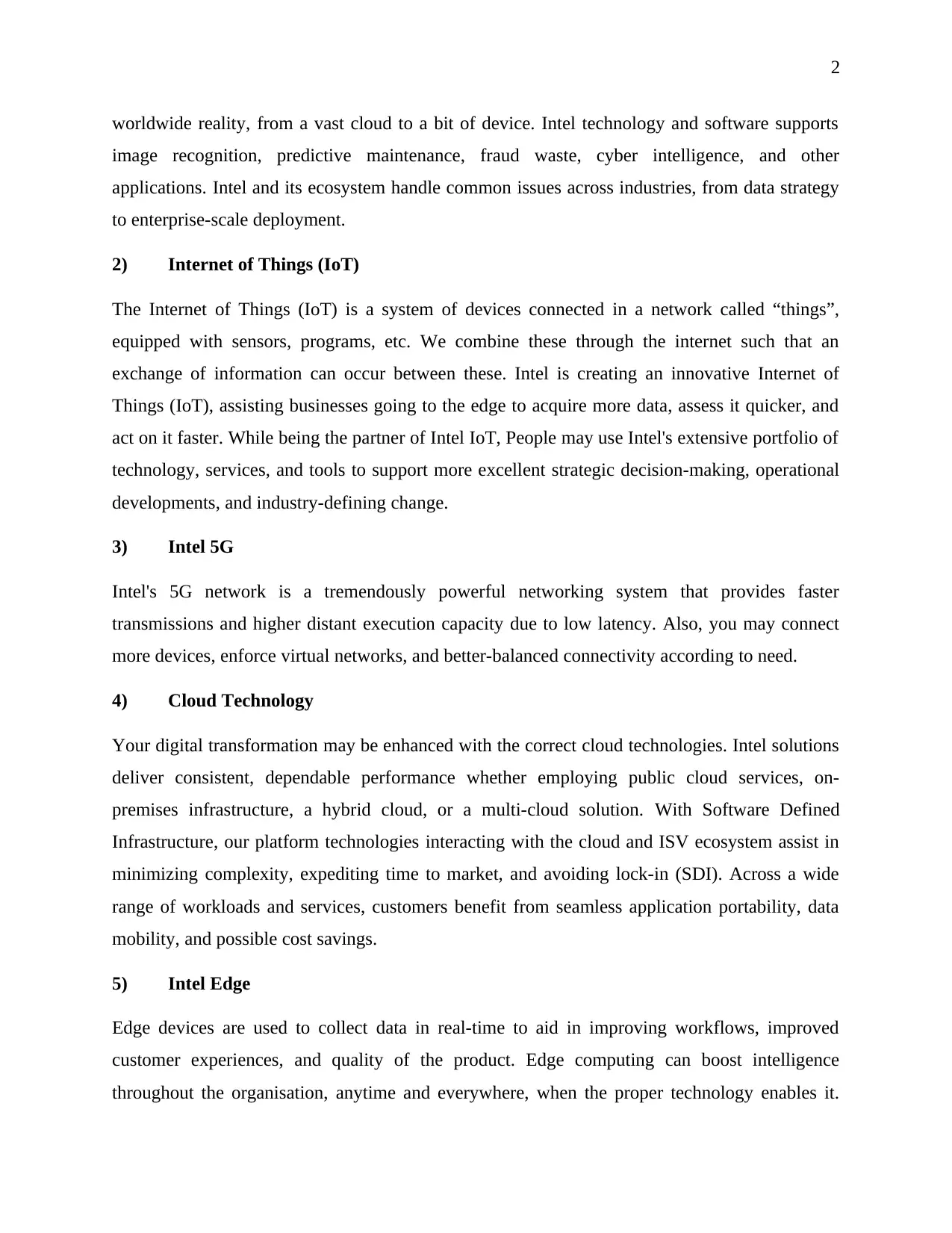
2
worldwide reality, from a vast cloud to a bit of device. Intel technology and software supports
image recognition, predictive maintenance, fraud waste, cyber intelligence, and other
applications. Intel and its ecosystem handle common issues across industries, from data strategy
to enterprise-scale deployment.
2) Internet of Things (IoT)
The Internet of Things (IoT) is a system of devices connected in a network called “things”,
equipped with sensors, programs, etc. We combine these through the internet such that an
exchange of information can occur between these. Intel is creating an innovative Internet of
Things (IoT), assisting businesses going to the edge to acquire more data, assess it quicker, and
act on it faster. While being the partner of Intel IoT, People may use Intel's extensive portfolio of
technology, services, and tools to support more excellent strategic decision-making, operational
developments, and industry-defining change.
3) Intel 5G
Intel's 5G network is a tremendously powerful networking system that provides faster
transmissions and higher distant execution capacity due to low latency. Also, you may connect
more devices, enforce virtual networks, and better-balanced connectivity according to need.
4) Cloud Technology
Your digital transformation may be enhanced with the correct cloud technologies. Intel solutions
deliver consistent, dependable performance whether employing public cloud services, on-
premises infrastructure, a hybrid cloud, or a multi-cloud solution. With Software Defined
Infrastructure, our platform technologies interacting with the cloud and ISV ecosystem assist in
minimizing complexity, expediting time to market, and avoiding lock-in (SDI). Across a wide
range of workloads and services, customers benefit from seamless application portability, data
mobility, and possible cost savings.
5) Intel Edge
Edge devices are used to collect data in real-time to aid in improving workflows, improved
customer experiences, and quality of the product. Edge computing can boost intelligence
throughout the organisation, anytime and everywhere, when the proper technology enables it.
worldwide reality, from a vast cloud to a bit of device. Intel technology and software supports
image recognition, predictive maintenance, fraud waste, cyber intelligence, and other
applications. Intel and its ecosystem handle common issues across industries, from data strategy
to enterprise-scale deployment.
2) Internet of Things (IoT)
The Internet of Things (IoT) is a system of devices connected in a network called “things”,
equipped with sensors, programs, etc. We combine these through the internet such that an
exchange of information can occur between these. Intel is creating an innovative Internet of
Things (IoT), assisting businesses going to the edge to acquire more data, assess it quicker, and
act on it faster. While being the partner of Intel IoT, People may use Intel's extensive portfolio of
technology, services, and tools to support more excellent strategic decision-making, operational
developments, and industry-defining change.
3) Intel 5G
Intel's 5G network is a tremendously powerful networking system that provides faster
transmissions and higher distant execution capacity due to low latency. Also, you may connect
more devices, enforce virtual networks, and better-balanced connectivity according to need.
4) Cloud Technology
Your digital transformation may be enhanced with the correct cloud technologies. Intel solutions
deliver consistent, dependable performance whether employing public cloud services, on-
premises infrastructure, a hybrid cloud, or a multi-cloud solution. With Software Defined
Infrastructure, our platform technologies interacting with the cloud and ISV ecosystem assist in
minimizing complexity, expediting time to market, and avoiding lock-in (SDI). Across a wide
range of workloads and services, customers benefit from seamless application portability, data
mobility, and possible cost savings.
5) Intel Edge
Edge devices are used to collect data in real-time to aid in improving workflows, improved
customer experiences, and quality of the product. Edge computing can boost intelligence
throughout the organisation, anytime and everywhere, when the proper technology enables it.
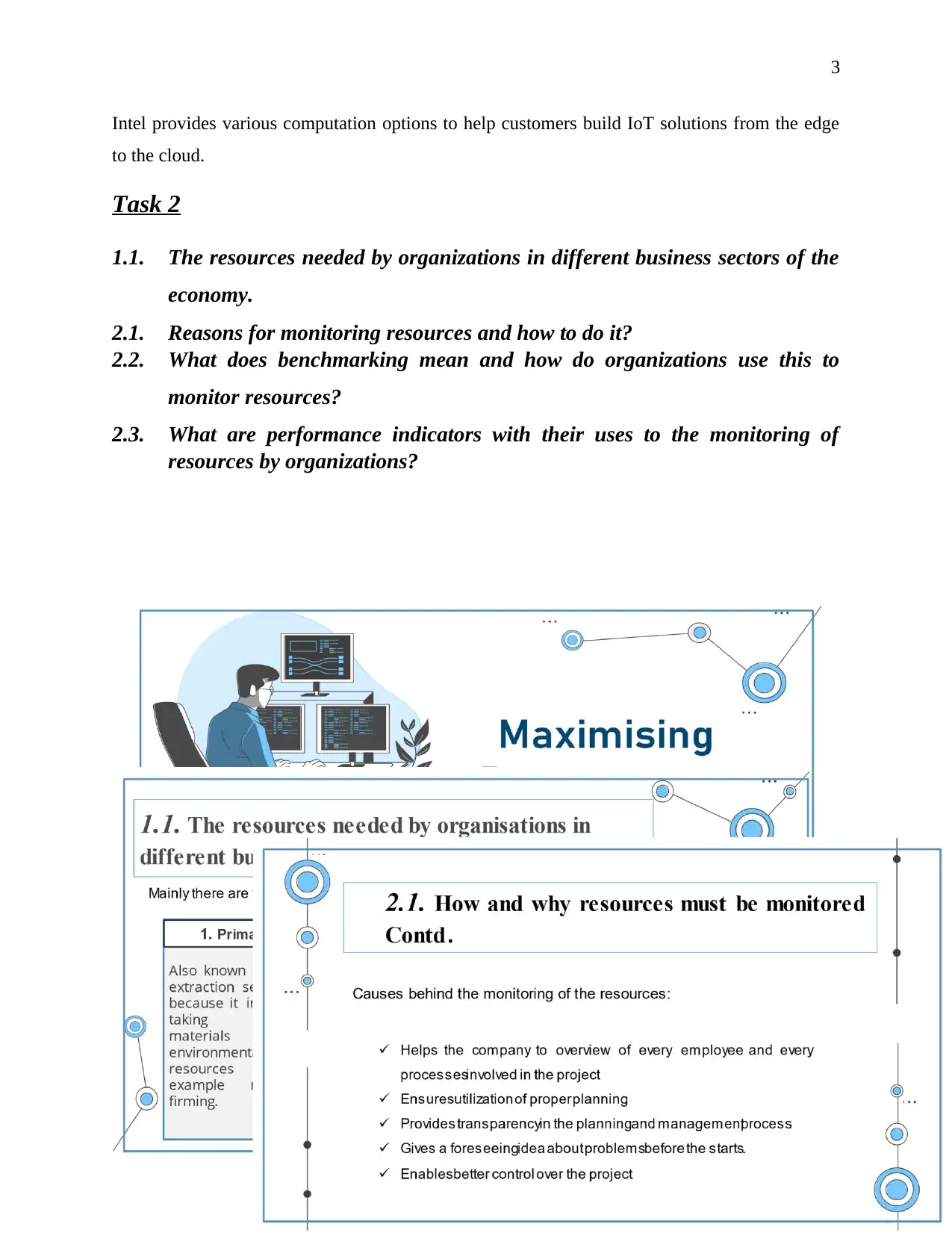
3
Intel provides various computation options to help customers build IoT solutions from the edge
to the cloud.
Task 2
1.1. The resources needed by organizations in different business sectors of the
economy.
2.1. Reasons for monitoring resources and how to do it?
2.2. What does benchmarking mean and how do organizations use this to
monitor resources?
2.3. What are performance indicators with their uses to the monitoring of
resources by organizations?
Intel provides various computation options to help customers build IoT solutions from the edge
to the cloud.
Task 2
1.1. The resources needed by organizations in different business sectors of the
economy.
2.1. Reasons for monitoring resources and how to do it?
2.2. What does benchmarking mean and how do organizations use this to
monitor resources?
2.3. What are performance indicators with their uses to the monitoring of
resources by organizations?
⊘ This is a preview!⊘
Do you want full access?
Subscribe today to unlock all pages.

Trusted by 1+ million students worldwide
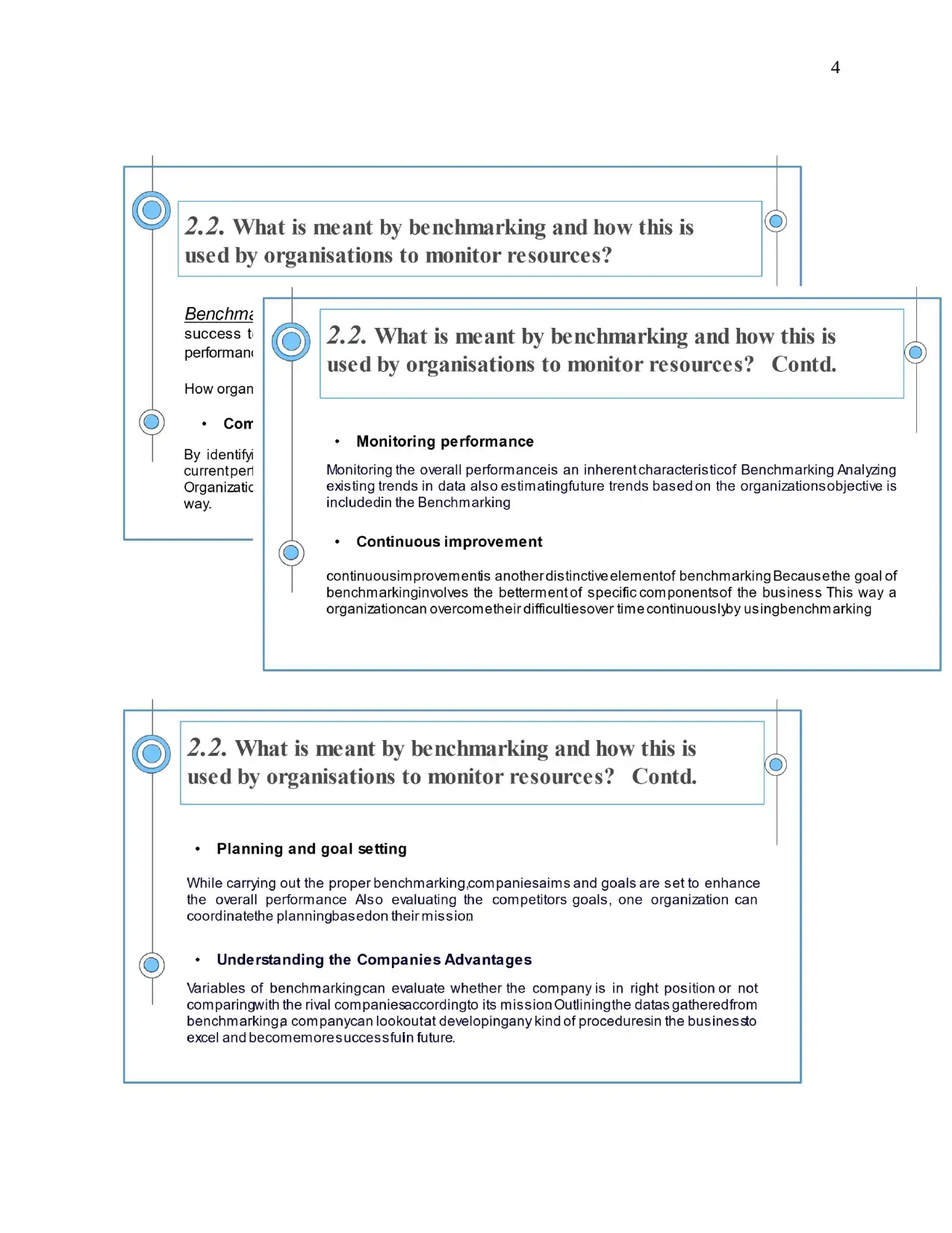
4
Paraphrase This Document
Need a fresh take? Get an instant paraphrase of this document with our AI Paraphraser
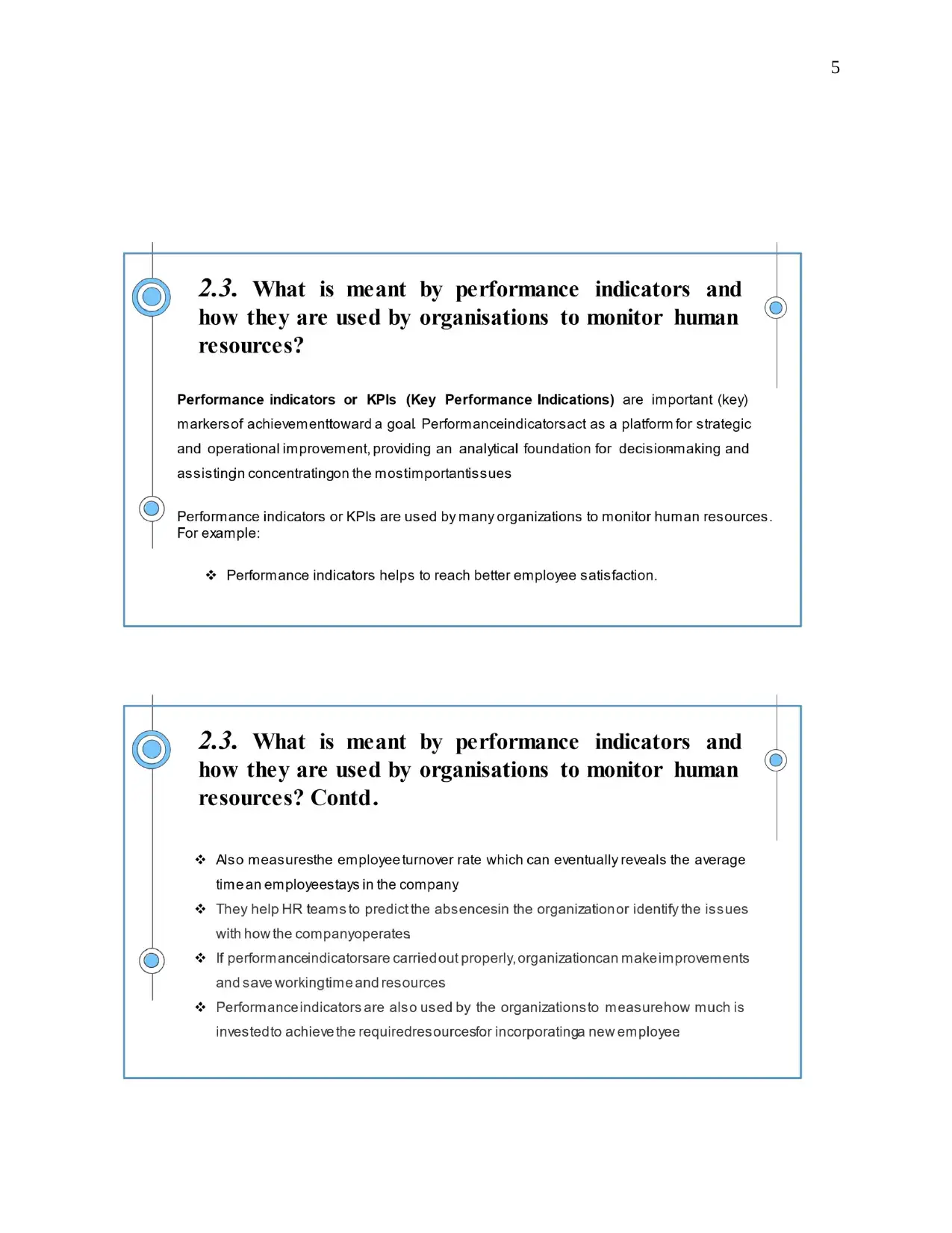
5
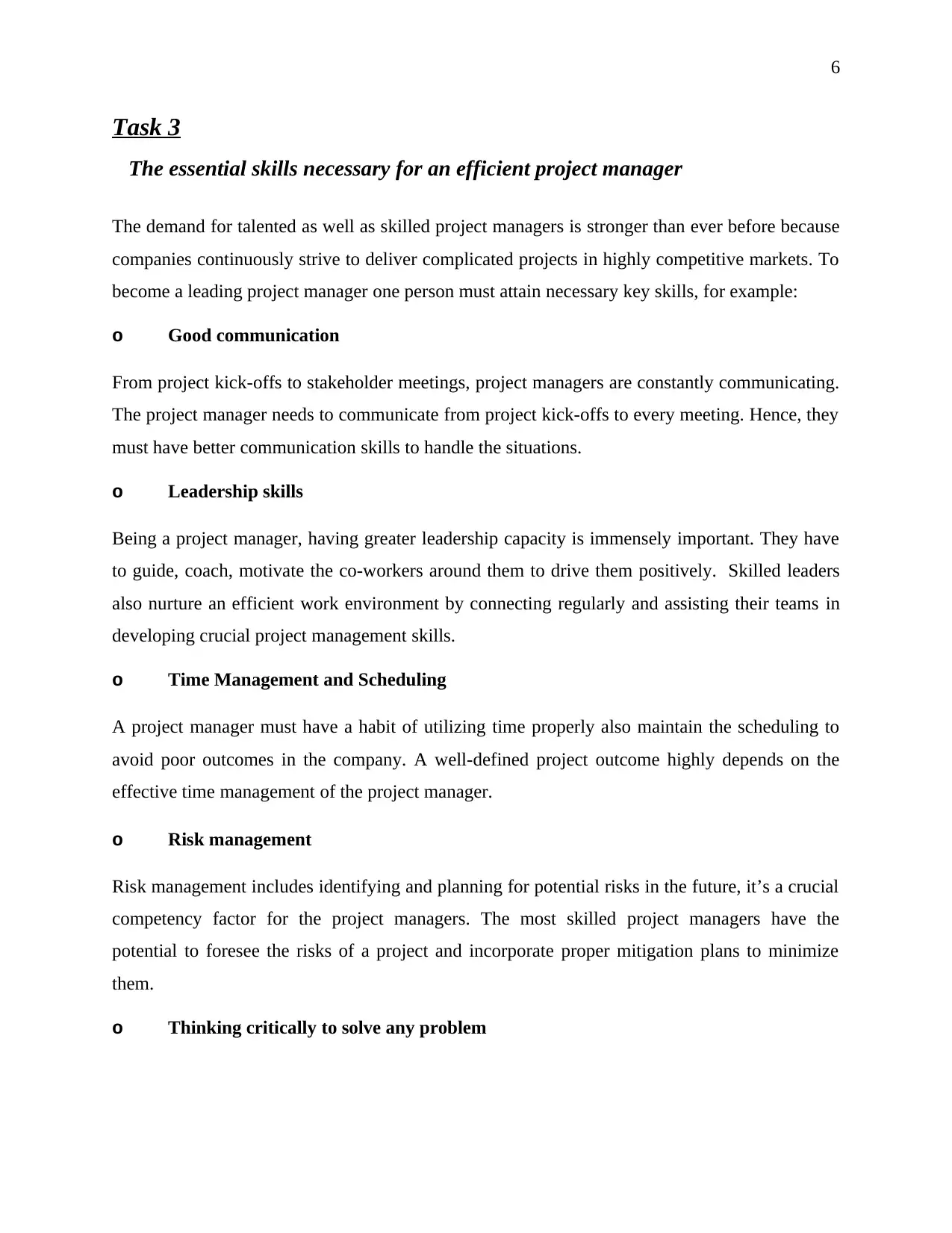
6
Task 3
The essential skills necessary for an efficient project manager
The demand for talented as well as skilled project managers is stronger than ever before because
companies continuously strive to deliver complicated projects in highly competitive markets. To
become a leading project manager one person must attain necessary key skills, for example:
o Good communication
From project kick-offs to stakeholder meetings, project managers are constantly communicating.
The project manager needs to communicate from project kick-offs to every meeting. Hence, they
must have better communication skills to handle the situations.
o Leadership skills
Being a project manager, having greater leadership capacity is immensely important. They have
to guide, coach, motivate the co-workers around them to drive them positively. Skilled leaders
also nurture an efficient work environment by connecting regularly and assisting their teams in
developing crucial project management skills.
o Time Management and Scheduling
A project manager must have a habit of utilizing time properly also maintain the scheduling to
avoid poor outcomes in the company. A well-defined project outcome highly depends on the
effective time management of the project manager.
o Risk management
Risk management includes identifying and planning for potential risks in the future, it’s a crucial
competency factor for the project managers. The most skilled project managers have the
potential to foresee the risks of a project and incorporate proper mitigation plans to minimize
them.
o Thinking critically to solve any problem
Task 3
The essential skills necessary for an efficient project manager
The demand for talented as well as skilled project managers is stronger than ever before because
companies continuously strive to deliver complicated projects in highly competitive markets. To
become a leading project manager one person must attain necessary key skills, for example:
o Good communication
From project kick-offs to stakeholder meetings, project managers are constantly communicating.
The project manager needs to communicate from project kick-offs to every meeting. Hence, they
must have better communication skills to handle the situations.
o Leadership skills
Being a project manager, having greater leadership capacity is immensely important. They have
to guide, coach, motivate the co-workers around them to drive them positively. Skilled leaders
also nurture an efficient work environment by connecting regularly and assisting their teams in
developing crucial project management skills.
o Time Management and Scheduling
A project manager must have a habit of utilizing time properly also maintain the scheduling to
avoid poor outcomes in the company. A well-defined project outcome highly depends on the
effective time management of the project manager.
o Risk management
Risk management includes identifying and planning for potential risks in the future, it’s a crucial
competency factor for the project managers. The most skilled project managers have the
potential to foresee the risks of a project and incorporate proper mitigation plans to minimize
them.
o Thinking critically to solve any problem
⊘ This is a preview!⊘
Do you want full access?
Subscribe today to unlock all pages.

Trusted by 1+ million students worldwide
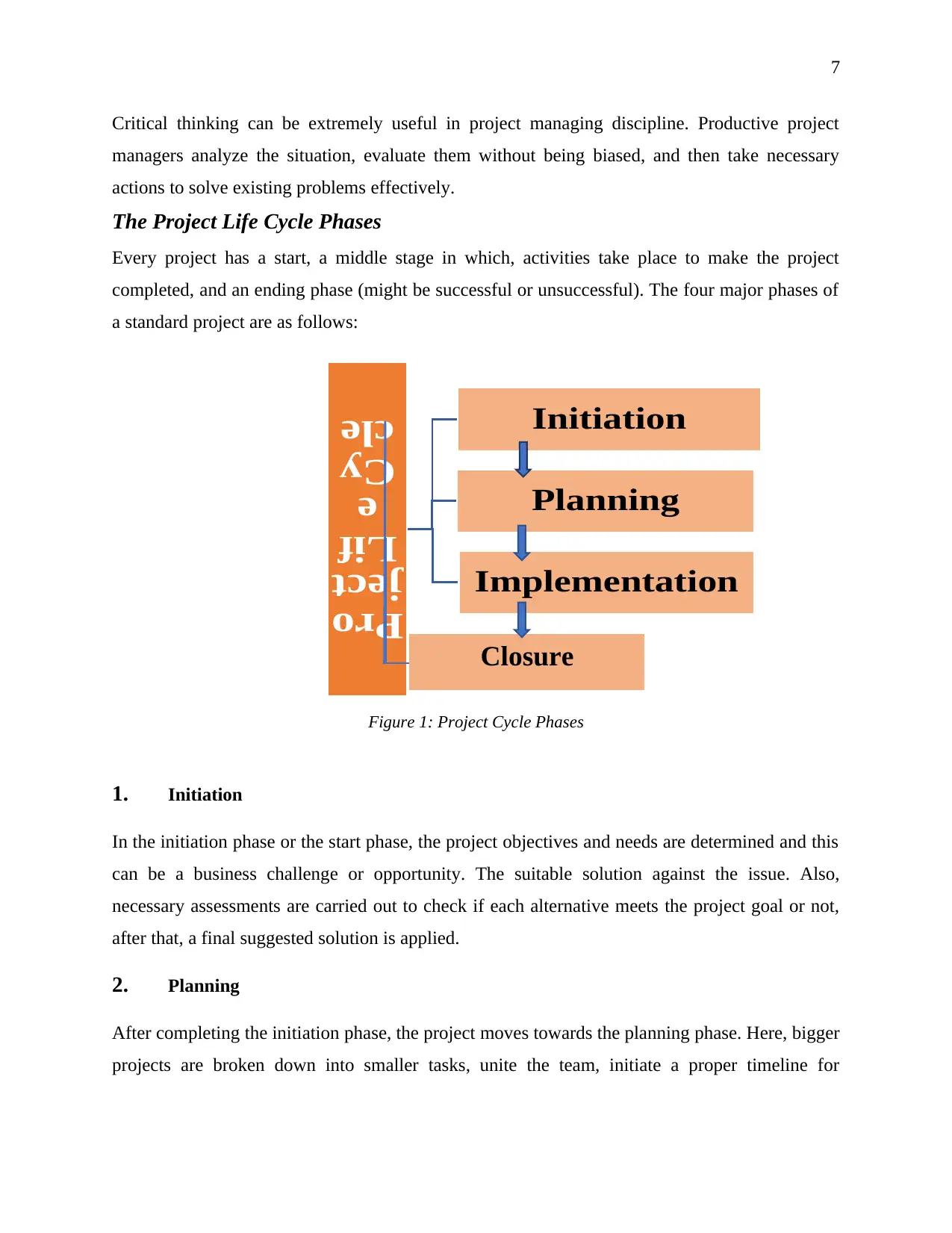
Figure 1: Project Cycle Phases
Pro
ject
Lif
e
Cy
cle Initiation
Planning
Implementation
7
Critical thinking can be extremely useful in project managing discipline. Productive project
managers analyze the situation, evaluate them without being biased, and then take necessary
actions to solve existing problems effectively.
The Project Life Cycle Phases
Every project has a start, a middle stage in which, activities take place to make the project
completed, and an ending phase (might be successful or unsuccessful). The four major phases of
a standard project are as follows:
1. Initiation
In the initiation phase or the start phase, the project objectives and needs are determined and this
can be a business challenge or opportunity. The suitable solution against the issue. Also,
necessary assessments are carried out to check if each alternative meets the project goal or not,
after that, a final suggested solution is applied.
2. Planning
After completing the initiation phase, the project moves towards the planning phase. Here, bigger
projects are broken down into smaller tasks, unite the team, initiate a proper timeline for
Closure
Pro
ject
Lif
e
Cy
cle Initiation
Planning
Implementation
7
Critical thinking can be extremely useful in project managing discipline. Productive project
managers analyze the situation, evaluate them without being biased, and then take necessary
actions to solve existing problems effectively.
The Project Life Cycle Phases
Every project has a start, a middle stage in which, activities take place to make the project
completed, and an ending phase (might be successful or unsuccessful). The four major phases of
a standard project are as follows:
1. Initiation
In the initiation phase or the start phase, the project objectives and needs are determined and this
can be a business challenge or opportunity. The suitable solution against the issue. Also,
necessary assessments are carried out to check if each alternative meets the project goal or not,
after that, a final suggested solution is applied.
2. Planning
After completing the initiation phase, the project moves towards the planning phase. Here, bigger
projects are broken down into smaller tasks, unite the team, initiate a proper timeline for
Closure
Paraphrase This Document
Need a fresh take? Get an instant paraphrase of this document with our AI Paraphraser
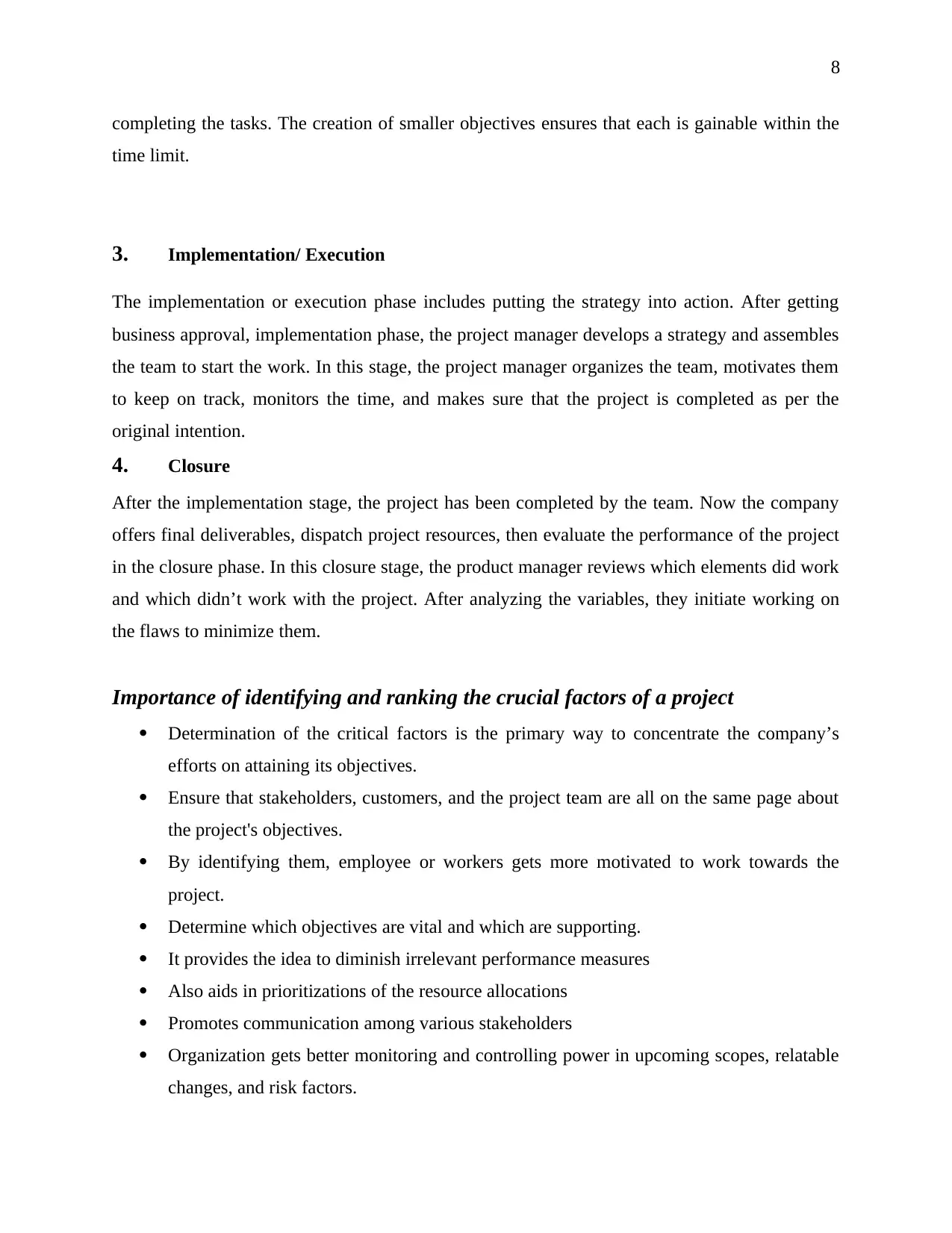
8
completing the tasks. The creation of smaller objectives ensures that each is gainable within the
time limit.
3. Implementation/ Execution
The implementation or execution phase includes putting the strategy into action. After getting
business approval, implementation phase, the project manager develops a strategy and assembles
the team to start the work. In this stage, the project manager organizes the team, motivates them
to keep on track, monitors the time, and makes sure that the project is completed as per the
original intention.
4. Closure
After the implementation stage, the project has been completed by the team. Now the company
offers final deliverables, dispatch project resources, then evaluate the performance of the project
in the closure phase. In this closure stage, the product manager reviews which elements did work
and which didn’t work with the project. After analyzing the variables, they initiate working on
the flaws to minimize them.
Importance of identifying and ranking the crucial factors of a project
Determination of the critical factors is the primary way to concentrate the company’s
efforts on attaining its objectives.
Ensure that stakeholders, customers, and the project team are all on the same page about
the project's objectives.
By identifying them, employee or workers gets more motivated to work towards the
project.
Determine which objectives are vital and which are supporting.
It provides the idea to diminish irrelevant performance measures
Also aids in prioritizations of the resource allocations
Promotes communication among various stakeholders
Organization gets better monitoring and controlling power in upcoming scopes, relatable
changes, and risk factors.
completing the tasks. The creation of smaller objectives ensures that each is gainable within the
time limit.
3. Implementation/ Execution
The implementation or execution phase includes putting the strategy into action. After getting
business approval, implementation phase, the project manager develops a strategy and assembles
the team to start the work. In this stage, the project manager organizes the team, motivates them
to keep on track, monitors the time, and makes sure that the project is completed as per the
original intention.
4. Closure
After the implementation stage, the project has been completed by the team. Now the company
offers final deliverables, dispatch project resources, then evaluate the performance of the project
in the closure phase. In this closure stage, the product manager reviews which elements did work
and which didn’t work with the project. After analyzing the variables, they initiate working on
the flaws to minimize them.
Importance of identifying and ranking the crucial factors of a project
Determination of the critical factors is the primary way to concentrate the company’s
efforts on attaining its objectives.
Ensure that stakeholders, customers, and the project team are all on the same page about
the project's objectives.
By identifying them, employee or workers gets more motivated to work towards the
project.
Determine which objectives are vital and which are supporting.
It provides the idea to diminish irrelevant performance measures
Also aids in prioritizations of the resource allocations
Promotes communication among various stakeholders
Organization gets better monitoring and controlling power in upcoming scopes, relatable
changes, and risk factors.
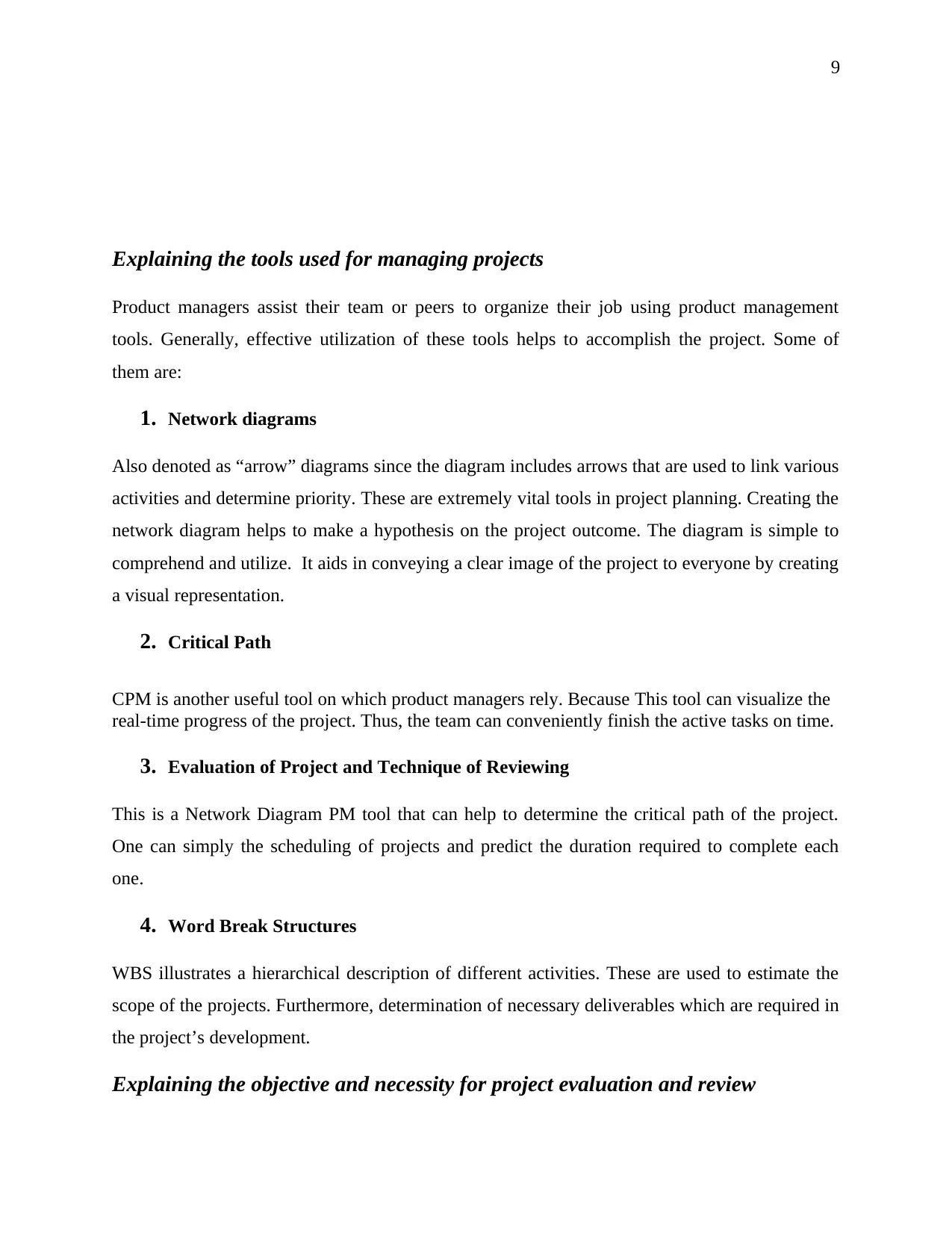
9
Explaining the tools used for managing projects
Product managers assist their team or peers to organize their job using product management
tools. Generally, effective utilization of these tools helps to accomplish the project. Some of
them are:
1. Network diagrams
Also denoted as “arrow” diagrams since the diagram includes arrows that are used to link various
activities and determine priority. These are extremely vital tools in project planning. Creating the
network diagram helps to make a hypothesis on the project outcome. The diagram is simple to
comprehend and utilize. It aids in conveying a clear image of the project to everyone by creating
a visual representation.
2. Critical Path
CPM is another useful tool on which product managers rely. Because This tool can visualize the
real-time progress of the project. Thus, the team can conveniently finish the active tasks on time.
3. Evaluation of Project and Technique of Reviewing
This is a Network Diagram PM tool that can help to determine the critical path of the project.
One can simply the scheduling of projects and predict the duration required to complete each
one.
4. Word Break Structures
WBS illustrates a hierarchical description of different activities. These are used to estimate the
scope of the projects. Furthermore, determination of necessary deliverables which are required in
the project’s development.
Explaining the objective and necessity for project evaluation and review
Explaining the tools used for managing projects
Product managers assist their team or peers to organize their job using product management
tools. Generally, effective utilization of these tools helps to accomplish the project. Some of
them are:
1. Network diagrams
Also denoted as “arrow” diagrams since the diagram includes arrows that are used to link various
activities and determine priority. These are extremely vital tools in project planning. Creating the
network diagram helps to make a hypothesis on the project outcome. The diagram is simple to
comprehend and utilize. It aids in conveying a clear image of the project to everyone by creating
a visual representation.
2. Critical Path
CPM is another useful tool on which product managers rely. Because This tool can visualize the
real-time progress of the project. Thus, the team can conveniently finish the active tasks on time.
3. Evaluation of Project and Technique of Reviewing
This is a Network Diagram PM tool that can help to determine the critical path of the project.
One can simply the scheduling of projects and predict the duration required to complete each
one.
4. Word Break Structures
WBS illustrates a hierarchical description of different activities. These are used to estimate the
scope of the projects. Furthermore, determination of necessary deliverables which are required in
the project’s development.
Explaining the objective and necessity for project evaluation and review
⊘ This is a preview!⊘
Do you want full access?
Subscribe today to unlock all pages.

Trusted by 1+ million students worldwide
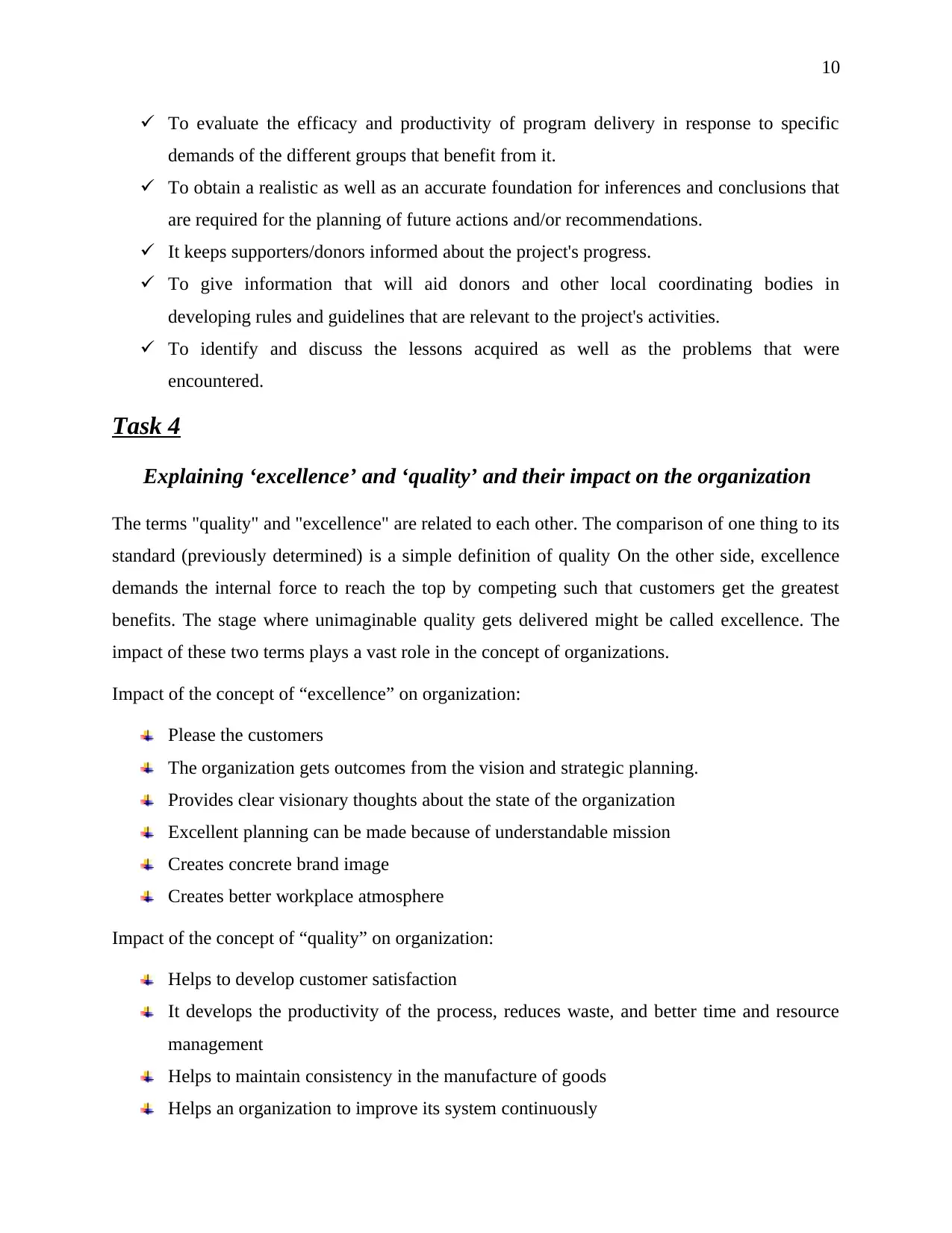
10
To evaluate the efficacy and productivity of program delivery in response to specific
demands of the different groups that benefit from it.
To obtain a realistic as well as an accurate foundation for inferences and conclusions that
are required for the planning of future actions and/or recommendations.
It keeps supporters/donors informed about the project's progress.
To give information that will aid donors and other local coordinating bodies in
developing rules and guidelines that are relevant to the project's activities.
To identify and discuss the lessons acquired as well as the problems that were
encountered.
Task 4
Explaining ‘excellence’ and ‘quality’ and their impact on the organization
The terms "quality" and "excellence" are related to each other. The comparison of one thing to its
standard (previously determined) is a simple definition of quality On the other side, excellence
demands the internal force to reach the top by competing such that customers get the greatest
benefits. The stage where unimaginable quality gets delivered might be called excellence. The
impact of these two terms plays a vast role in the concept of organizations.
Impact of the concept of “excellence” on organization:
Please the customers
The organization gets outcomes from the vision and strategic planning.
Provides clear visionary thoughts about the state of the organization
Excellent planning can be made because of understandable mission
Creates concrete brand image
Creates better workplace atmosphere
Impact of the concept of “quality” on organization:
Helps to develop customer satisfaction
It develops the productivity of the process, reduces waste, and better time and resource
management
Helps to maintain consistency in the manufacture of goods
Helps an organization to improve its system continuously
To evaluate the efficacy and productivity of program delivery in response to specific
demands of the different groups that benefit from it.
To obtain a realistic as well as an accurate foundation for inferences and conclusions that
are required for the planning of future actions and/or recommendations.
It keeps supporters/donors informed about the project's progress.
To give information that will aid donors and other local coordinating bodies in
developing rules and guidelines that are relevant to the project's activities.
To identify and discuss the lessons acquired as well as the problems that were
encountered.
Task 4
Explaining ‘excellence’ and ‘quality’ and their impact on the organization
The terms "quality" and "excellence" are related to each other. The comparison of one thing to its
standard (previously determined) is a simple definition of quality On the other side, excellence
demands the internal force to reach the top by competing such that customers get the greatest
benefits. The stage where unimaginable quality gets delivered might be called excellence. The
impact of these two terms plays a vast role in the concept of organizations.
Impact of the concept of “excellence” on organization:
Please the customers
The organization gets outcomes from the vision and strategic planning.
Provides clear visionary thoughts about the state of the organization
Excellent planning can be made because of understandable mission
Creates concrete brand image
Creates better workplace atmosphere
Impact of the concept of “quality” on organization:
Helps to develop customer satisfaction
It develops the productivity of the process, reduces waste, and better time and resource
management
Helps to maintain consistency in the manufacture of goods
Helps an organization to improve its system continuously
Paraphrase This Document
Need a fresh take? Get an instant paraphrase of this document with our AI Paraphraser
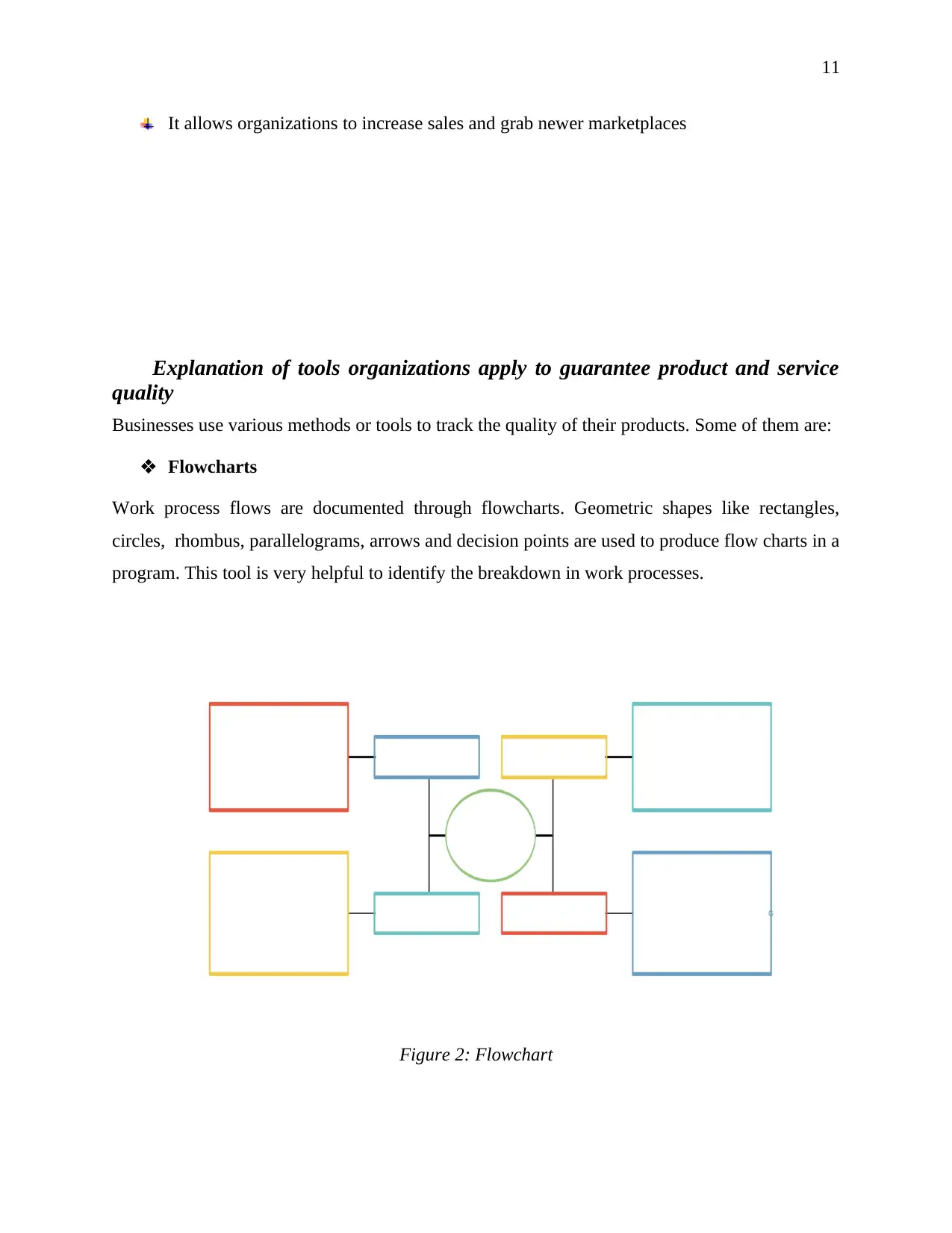
Figure 2: Flowchart
11
It allows organizations to increase sales and grab newer marketplaces
Explanation of tools organizations apply to guarantee product and service
quality
Businesses use various methods or tools to track the quality of their products. Some of them are:
Flowcharts
Work process flows are documented through flowcharts. Geometric shapes like rectangles,
circles, rhombus, parallelograms, arrows and decision points are used to produce flow charts in a
program. This tool is very helpful to identify the breakdown in work processes.
11
It allows organizations to increase sales and grab newer marketplaces
Explanation of tools organizations apply to guarantee product and service
quality
Businesses use various methods or tools to track the quality of their products. Some of them are:
Flowcharts
Work process flows are documented through flowcharts. Geometric shapes like rectangles,
circles, rhombus, parallelograms, arrows and decision points are used to produce flow charts in a
program. This tool is very helpful to identify the breakdown in work processes.
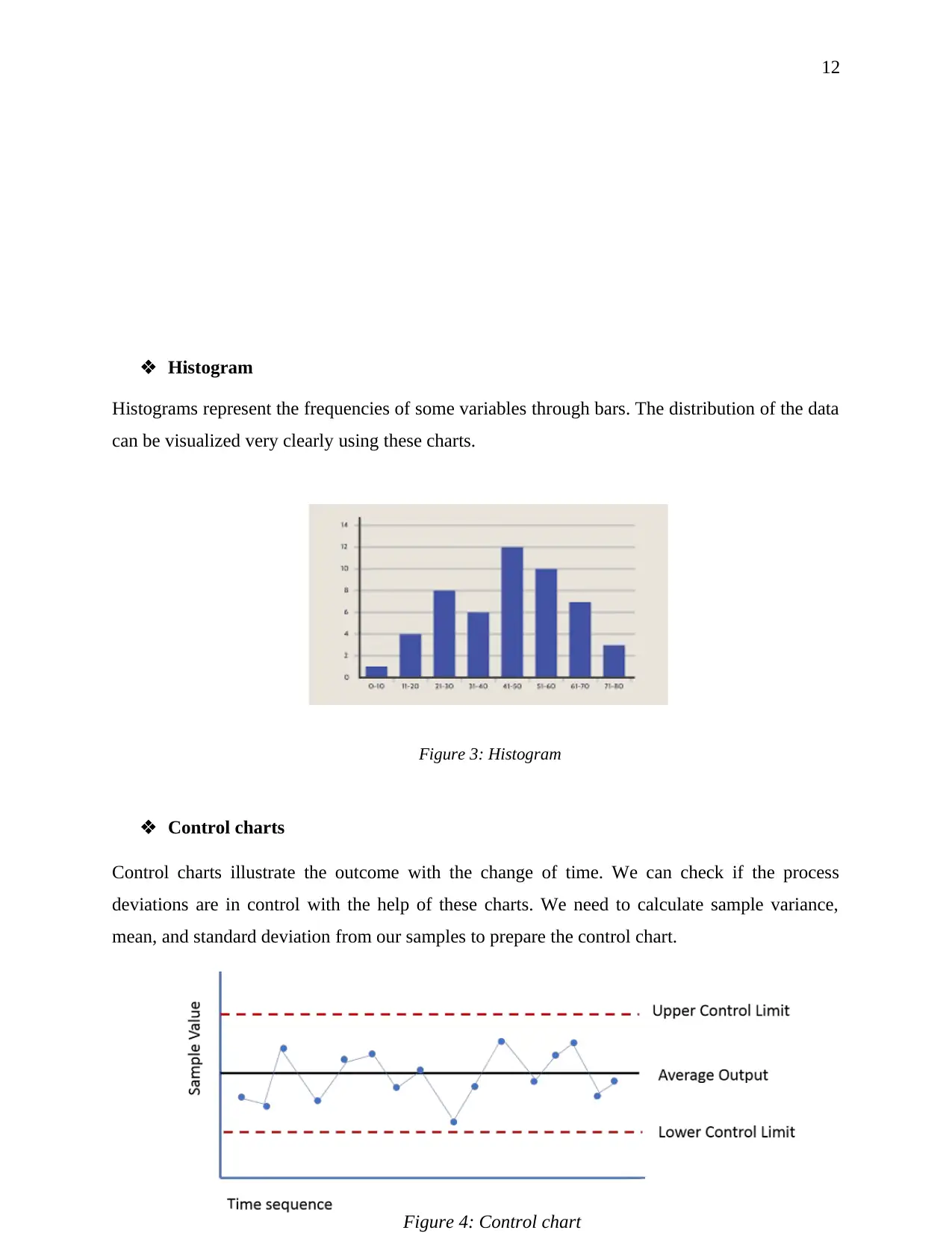
Figure 3: Histogram
Figure 4: Control chart
12
Histogram
Histograms represent the frequencies of some variables through bars. The distribution of the data
can be visualized very clearly using these charts.
Control charts
Control charts illustrate the outcome with the change of time. We can check if the process
deviations are in control with the help of these charts. We need to calculate sample variance,
mean, and standard deviation from our samples to prepare the control chart.
Figure 4: Control chart
12
Histogram
Histograms represent the frequencies of some variables through bars. The distribution of the data
can be visualized very clearly using these charts.
Control charts
Control charts illustrate the outcome with the change of time. We can check if the process
deviations are in control with the help of these charts. We need to calculate sample variance,
mean, and standard deviation from our samples to prepare the control chart.
⊘ This is a preview!⊘
Do you want full access?
Subscribe today to unlock all pages.

Trusted by 1+ million students worldwide
1 out of 13
Related Documents
Your All-in-One AI-Powered Toolkit for Academic Success.
+13062052269
info@desklib.com
Available 24*7 on WhatsApp / Email
![[object Object]](/_next/static/media/star-bottom.7253800d.svg)
Unlock your academic potential
Copyright © 2020–2025 A2Z Services. All Rights Reserved. Developed and managed by ZUCOL.





